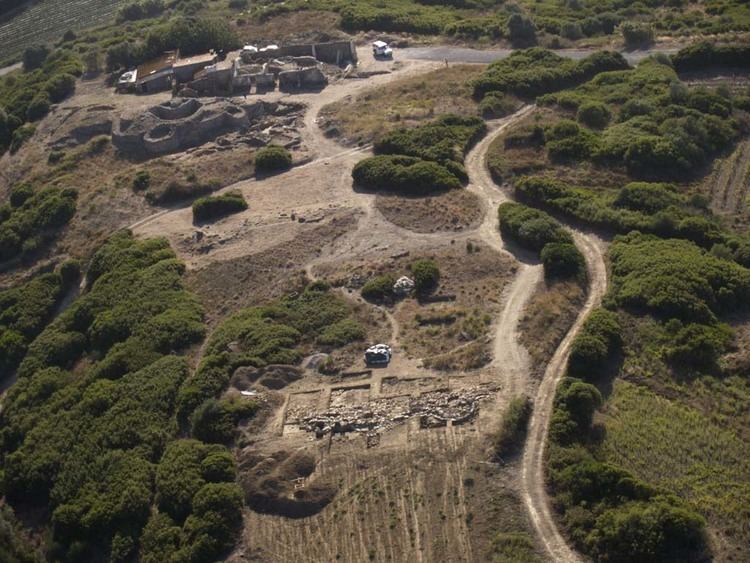Elevation 86 m | ||
 | ||
Similar Museu Municipal Leonel Tr, Lines of Torres Vedras, Forte de São Vicente d, Castelo de Torres Vedras, Chafariz dos Canos | ||
The Castro of Zambujal (Portuguese: Castro do Zambujal) is a Neolithic age archeological site in the civil parish of Santa Maria do Castelo e São Miguel, municipality of Torres Vedras in the western littoral area of the Portuguese Centro Region. The Zambujal Castro is one of the most important Copper Age settlements in the peninsula of Lisbon, and whose culture lasted until the beginning of the agrarian periods of Iberian history. Apart from being the most northerly discovered Copper Age site in Portugal, it went through two main building phases: an import-oriented phase and the second associated with the Beaker culture.
Contents
Excavations
The site was discovered and interpreted in 1932 by the Portuguese archaeologist Leonel Trindade, who, made the first investigation in 1944, and together with Aurélio Racardo Belo in 1959-1961. From 1964 to 1973 the excavations were directed by Hermanfrid Schubart.(German Archaeological Institute) and Edward Sangmeister (University of Freiburg).
New excavations were started in 1994 and 1995 by Michael Kunst (German Archaeological Institute) and Hans-Peter Uerpmann (University of Tübingen), the work was continued by Michael Kunst (German Archaeological Institute) with the support of the Municipal Council of Torres Vedras. From 1964 until nowadays the project is manely financed by the German Archaeological Institute of Madrid.
History
Occupation of the site was initiated in the Chalcolithic period, in the beginning of the 3rd millennium BC. Research of the last 30 years suggest that the region of the actual Portuguese Estremadura in Central Portugal was the region where the so-called Bell Beaker phenomenon started around the middle of the 3rd millennium BC, and from there spread to other European regions during the later Chalcolithic or early Bronze Age. In this context Zambujal is with its relative good conservation (some walls existing still up to a height of 4 meters) and large stratigraphies one of the most important sites. The site and surrounding land was specifically tied to a Chalcolithic settlement that constructed a wall around itself to protect its community from attack. The settlers, who may have been from the peninsula but perhaps with Eastern Mediterranean contacts, based their economy on intensive farming. They were also part of an economic network importing minerals like copper and amphibolit stone, also ivory and gold, between 3000 and 1700 BC.
According to the excavations and analysis of Edward Sangmeister, Hermanfrid Schubart, and Leonel Trindade (1969), the site went through successive phases of occupation and development:
Although uncertain as to the date, the fortification was partially destroyed (principally the central structures) in order to construct a rural adobe farmhouse (today known as the Casal do Zambujal).
Architecture
The site is located in the semi-rural area of the parish of Santa Maria do Castelo e São Miguel, along one of the flanks of the Serra do Varatojo mountain range. Situated on a platform, the location extends down towards the Sizandro River, approximately 3 kilometres (1.9 mi) from the urban center of Torres Vedras.
Of the original fortification only the central body remains. The interior courtyard includes a space approximately 25 metres (82 ft) diameter, circled by a solid wall, which runs independently for several metres. The exterior is reinforced by 10 cubels, in a semi-circular layout and with diameters varying between 6 metres (20 ft) and 7 metres (23 ft). Of these, four are complete and one incomplete, while five are totally destroyed. The walls themselves range from 1.6 metres (5.2 ft) to 3.6 metres (12 ft) in width and 3 metres (9.8 ft) to 7 metres (23 ft) in height.
There are four doors within the structure (south, north, northeast and west), with the likelihood that six doors or passageways provided access to the courtyard between the fortifications inner and outer walls. These passages were short and narrow and permitted only one person at a time from accessing the spaces, likely on all-fours. One of the spaces connects the battlement's gallery and these passages.
The houses on-site were constructed from adobe, in an oval shape, approximately 6 metres (20 ft) in diameter.
Current projects
To combat archaeological ruin and problems, the Municipal Council of Torres Vedras acquired 48 hectares to guarantee the protection of the national monument in 2006. Most of the artefacts discovered at the site are stored and displayed in the Municipal Museum. The Portuguese Institute of Architectural Patrimony and Archaeology (IPPAR) has an architectural project to restore the adobe houses adjacent to the site, as well as a landscaping project, which included fencing the site, creating greenspaces, and the construction of support facilities, walkways/trails, explanatory signs and a small museum.
